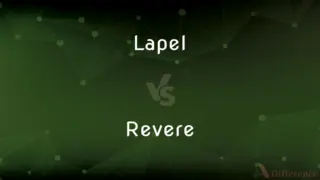Ganja vs. Charas — What's the Difference?
By Fiza Rafique & Maham Liaqat — Updated on May 7, 2024
Ganja refers to the dried flower buds of the cannabis plant used for smoking, whereas charas is a type of hashish made by hand-rubbing the resin from fresh cannabis plants. Both originate from cannabis but differ in their forms and preparation methods.

Difference Between Ganja and Charas
Table of Contents
ADVERTISEMENT
Key Differences
Ganja is made from the dried flower buds and leaves of the cannabis plant, which are then used directly for smoking. Charas, on the other hand, is a resinous extract made by rubbing fresh cannabis flowers and leaves by hand.
Ganja is generally more available and is directly consumed without further processing, while charas requires more effort to produce as it involves hand-extraction and rolling of fresh resin.
Ganja is often used in countries where cannabis is culturally accepted or legally permitted, whereas charas is traditionally linked to the Himalayan regions where cannabis grows naturally.
Ganja can have a lower concentration of THC compared to charas because charas, as a form of hashish, is a concentrated form of the plant's psychoactive compounds.
Ganja usually has a distinctive herbal aroma due to its dried flower state, while charas has a stronger, more pungent scent from its concentrated resin content.
ADVERTISEMENT
Comparison Chart
Origin
Dried flower buds of the cannabis plant
Resin extracted from fresh cannabis plants
Preparation Method
Harvesting and drying
Hand-rubbing and rolling
THC Concentration
Typically lower
Higher due to concentration
Aroma
Herbal, plant-like
Stronger, pungent
Regional Association
Globally used where cannabis is accepted
Traditionally linked to Himalayan regions
Compare with Definitions
Ganja
Dried leaves and flowers of the cannabis plant.
The ganja sold in the market was freshly harvested.
Charas
Concentrated resin extract from the cannabis plant.
He offered the charas, carefully prepared from his farm.
Ganja
Plant matter used for smoking or medicinal purposes.
He uses ganja as an herbal remedy for relaxation.
Charas
Traditionally produced in Himalayan regions.
The charas was sourced directly from the Himalayan foothills.
Ganja
Used for personal enjoyment or relaxation.
The group gathered to share some ganja in the evening.
Charas
High in THC content due to resin extraction.
Charas often provides stronger effects than ganja due to its concentrated form.
Ganja
Consumption for health or therapeutic benefits.
She obtained ganja with a prescription for chronic pain.
Charas
Impacting mood or consciousness.
The psychoactive effects of charas are quite potent.
Ganja
Laws permitting the regulated sale and use.
Many states have legalized ganja for medical purposes.
Charas
Made by manually rubbing the fresh plant to extract resin.
The charas was hand-rubbed and rolled into small balls.
Ganja
Marijuana.
Charas
Charas is a cannabis concentrate made from the resin of a live cannabis plant (Cannabis sativa or Cannabis indica) and is handmade in the Indian subcontinent and Jamaica. The plant grows wild throughout Northern India along the stretch of the Himalayas (its putative origin) and is an important cash crop for the local people.
Ganja
Marijuana, as used for smoking.
Charas
Cannabis resin, used as an intoxicant in India.
Ganja
The dried hemp plant, used in India for smoking. It is extremely narcotic and intoxicating.
Ganja
A strong-smelling plant from whose dried leaves a number of euphoriant and hallucinogenic drugs are prepared
Ganja
The most commonly used illicit drug; considered a soft drug, it consists of the dried leaves of the hemp plant; smoked or chewed for euphoric effect
Common Curiosities
Where does charas traditionally come from?
It is traditionally made in Himalayan regions, like India and Nepal.
Is charas legal in most countries?
No, charas is generally illegal due to strict cannabis regulations.
What is the main difference between ganja and charas?
Ganja is the dried flowers of cannabis, while charas is a hand-rubbed resin extract.
Can ganja and charas be used medically?
Yes, both can have therapeutic applications where permitted by law.
Which is stronger, ganja or charas?
Charas is typically stronger due to its concentrated THC content.
How is charas traditionally made?
It is made by rubbing fresh cannabis plants by hand to collect the resin.
Is ganja the same as marijuana?
Yes, ganja is a colloquial term for marijuana, particularly the dried flowers and leaves of the cannabis plant.
Is ganja always dried before consumption?
Typically, yes, it is dried to improve its smokability and shelf life.
Does ganja have higher CBD content than charas?
Not necessarily. CBD levels depend on the specific cannabis strain.
Is ganja easier to produce than charas?
Yes, as ganja involves simpler processing, while charas needs skilled hand-extraction.
Does ganja have a unique aroma compared to charas?
Yes, ganja has a herbal scent, while charas has a stronger, resinous smell.
Can charas be smoked directly like ganja?
Yes, charas is often smoked, but it requires specialized preparation.
Are ganja and charas produced from the same cannabis strains?
Not necessarily; charas is often made from specific, resin-rich strains.
Is the production of charas environmentally sustainable?
It depends on the farming practices used and the region's regulations.
Can both ganja and charas be used in edibles?
Yes, both can be processed into edible forms for consumption.
Share Your Discovery

Previous Comparison
Lapel vs. Revere
Next Comparison
Kale vs. LettuceAuthor Spotlight
Written by
Fiza RafiqueFiza Rafique is a skilled content writer at AskDifference.com, where she meticulously refines and enhances written pieces. Drawing from her vast editorial expertise, Fiza ensures clarity, accuracy, and precision in every article. Passionate about language, she continually seeks to elevate the quality of content for readers worldwide.
Co-written by
Maham Liaqat














































